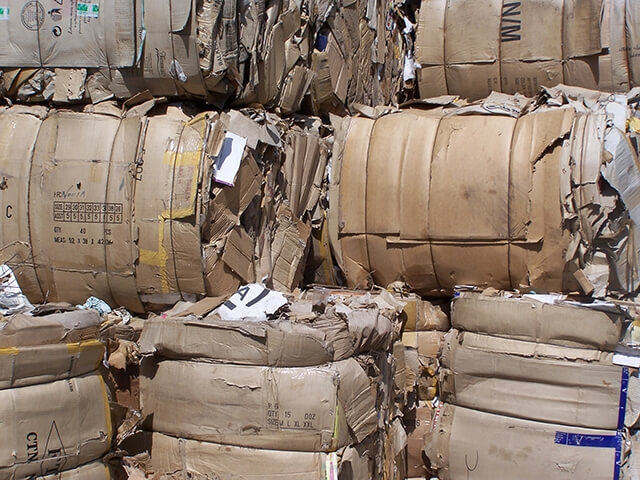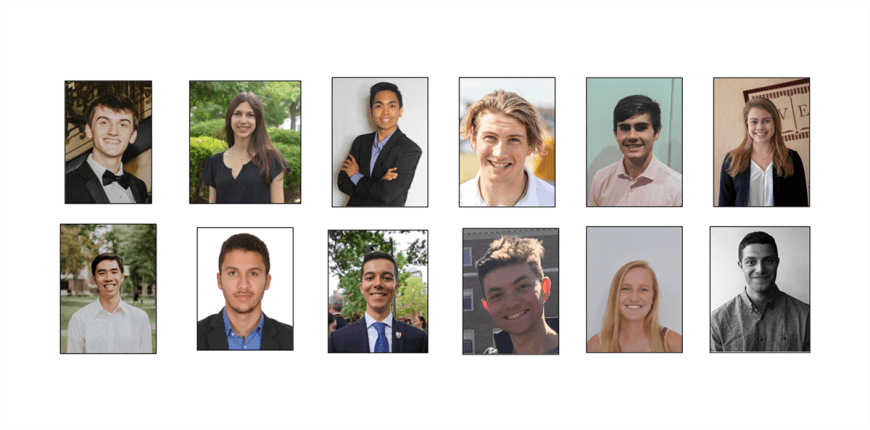News
Students in the course Engineering Problem Solving and Design Project (ES 96) developed a multi-pronged solution that includes a system to capture cardboard that otherwise might be thrown away, as well as a website to incentivize students to recycle.
Of the roughly 19,500 tons of refuse Harvard University generated last year, about 22 percent wound up in single-stream recycling bins.
But that’s not the whole picture—about 20 percent of would-be recyclables found their way into trash cans instead. In fact, the University was fined three times last year by the Massachusetts Department of Environmental Protection for having too much recyclable cardboard in the trash (the fines were the first the University has incurred in 25 years).
Working with the University’s Operations Services team, students in Engineering Problem Solving and Design Project (ES 96) set out to develop monitoring systems to identify and eliminate recyclable materials that were ending up in the trash. The Harvard John A. Paulson School of Engineering and Applied Sciences course challenges students to use engineering design skills to create a solution to a problem faced by a real-world client. The juniors in the course, who represent all five engineering concentrations, collaborate to design and drive the entire project.
After studying the problem from many angles, the students focused on the recyclable most commonly found in trash: cardboard. Due to the prevalence of online shopping, the University receives about a million cardboard boxes through the mail each year, 20 percent of which arrive within the first two weeks of the academic year.
“Recycling is a large and complex operation, requiring the coordination of many stakeholders, and there were many different projects we could have worked on,” said project co-lead Victor Qin, S.B. ’21, an electrical engineering concentrator. “We eventually narrowed it down through discussions with our client, and by examining the issues that we could tackle with limited time and resources, yet had the potential to significantly help Harvard.”
The students developed a multi-pronged solution that includes a system to capture cardboard that otherwise might be thrown away, as well as a website to incentivize students to recycle.
They suggested the University create a centralized recycling node where students could bring cardboard, flatten the boxes using onsite tools, and then take a photo of the flattened box to receive “credit” later for recycling.
They also designed an intermediary attachment for the front of a compactor that divides the trash and recycling into two troughs, with clear shielding above the troughs so workers can more easily identify recycling that is in the wrong stream and remove it.
In addition, they developed a tag and recapture system in which mail center workers would add QR code stickers to cardboard boxes. Students would scan the code when they dispose of the box, giving administrators information about how and where cardboard enters the trash system via an online database. The data could also used to incentivize students to recycle through the proposed MyCrimson website.
Using MyCrimson, students complete actions, like recycling cardboard, taking shorter showers, or turning lights off before they leave a room, and then earn points that can be redeemed for prizes like water bottles or Crimson Cash. The prizes, and a competition to see which House earns the most points, would help encourage students to participate, said Nicky Wojtania, S.B. ’21, a bioengineering concentrator.
“We hope that in the short-term, the MyCrimson program will keep students accountable and motivated in reaching Harvard’s sustainability goals, while in the long-term instill habits surrounding reuse, recycling, and sustainability,” she said.
Ultimately, the students see their solutions as vital to helping the University reach its sustainability commitments, which include reducing waste per capita by 50 percent in 2020 and becoming a zero-waste campus in the future.
The costs of these solutions could be offset with money saved from reduced fines and lower energy costs, said project co-lead Ethan Seder, S.B. ’21, a mechanical engineering concentrator.
He is proud of what he and his classmates accomplished over the course of the semester. Even with the disruption from the University’s transition to remote instruction in the middle of the project, ES 96 was a valuable learning experience, he said.
“The most surprising thing I learned from this project was the complexity of the Harvard waste system,” he said. “Due to Harvard’s decentralized system of over 1,000 buildings, the waste team has to work incredibly hard on a daily basis to pick up trash at every facility. Harvard handles over 15 to 20 thousand tons of trash a year. A targeted focus from students and faculty is the only way to reduce the recyclable material getting into landfills, the only way to make Harvard an environmentally friendly institution.”
Instructor Kelly Miller, Senior Preceptor in Applied Physics, hopes this project taught students how to apply a problem-solving process to an open-ended, real-world problem.
“I was impressed by the level of intensity and professionalism my section maintained after the movement to online classes. Many of the students were dealing with international time zones, spotty internet, and challenging living situations, but you would never know that based on the quality of the solutions they came up,” she said. “The solutions proposed were both innovative and practical. They did an excellent job of addressing the cardboard recycling problems on campus and suggesting ways that Harvard can use its existing infrastructure to manage the sustainability resources more effectively and efficiently. I am very proud of all the students; their resilience throughout the semester as well as the solution that they came up with—I think it could have a real impact on recycling and sustainability at Harvard.”
The team’s client, Robert Gogan, Associate Manager of Recycling and Waste Services, was also impressed by the work the students accomplished.
“I was amazed at how quickly the ES 96 team grasped the essential elements of recycling. They really focused on information, accountability and incentives,” he said. “We have already implemented aspects of the team’s recommendations and look forward to applying more once students come back to campus.”
Topics: Academics
Cutting-edge science delivered direct to your inbox.
Join the Harvard SEAS mailing list.
Press Contact
Adam Zewe | 617-496-5878 | azewe@seas.harvard.edu




